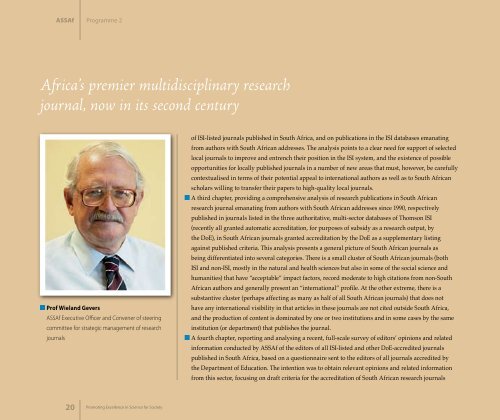Academy of Science South Africa 2005/6 Annual Report
Academy of Science South Africa 2005/6 Annual Report
Academy of Science South Africa 2005/6 Annual Report
- No tags were found...
Create successful ePaper yourself
Turn your PDF publications into a flip-book with our unique Google optimized e-Paper software.
ASSAfProgramme 2<strong>Africa</strong>’s premier multidisciplinary researchjournal, now in its second centuryPr<strong>of</strong> Wieland GeversASSAf Executive Officer and Convener <strong>of</strong> steeringcommittee for strategic management <strong>of</strong> researchjournals<strong>of</strong> ISI-listed journals published in <strong>South</strong> <strong>Africa</strong>, and on publications in the ISI databases emanatingfrom authors with <strong>South</strong> <strong>Africa</strong>n addresses. The analysis points to a clear need for support <strong>of</strong> selectedlocal journals to improve and entrench their position in the ISI system, and the existence <strong>of</strong> possibleopportunities for locally published journals in a number <strong>of</strong> new areas that must, however, be carefullycontextualised in terms <strong>of</strong> their potential appeal to international authors as well as to <strong>South</strong> <strong>Africa</strong>nscholars willing to transfer their papers to high-quality local journals.A third chapter, providing a comprehensive analysis <strong>of</strong> research publications in <strong>South</strong> <strong>Africa</strong>nresearch journal emanating from authors with <strong>South</strong> <strong>Africa</strong>n addresses since 1990, respectivelypublished in journals listed in the three authoritative, multi-sector databases <strong>of</strong> Thomson ISI(recently all granted automatic accreditation, for purposes <strong>of</strong> subsidy as a research output, bythe DoE), in <strong>South</strong> <strong>Africa</strong>n journals granted accreditation by the DoE as a supplementary listingagainst published criteria. This analysis presents a general picture <strong>of</strong> <strong>South</strong> <strong>Africa</strong>n journals asbeing differentiated into several categories. There is a small cluster <strong>of</strong> <strong>South</strong> <strong>Africa</strong>n journals (bothISI and non-ISI, mostly in the natural and health sciences but also in some <strong>of</strong> the social science andhumanities) that have “acceptable” impact factors, record moderate to high citations from non-<strong>South</strong><strong>Africa</strong>n authors and generally present an “international” pr<strong>of</strong>ile. At the other extreme, there is asubstantive cluster (perhaps affecting as many as half <strong>of</strong> all <strong>South</strong> <strong>Africa</strong>n journals) that does nothave any international visibility in that articles in these journals are not cited outside <strong>South</strong> <strong>Africa</strong>,and the production <strong>of</strong> content is dominated by one or two institutions and in some cases by the sameinstitution (or department) that publishes the journal.A fourth chapter, reporting and analysing a recent, full-scale survey <strong>of</strong> editors’ opinions and relatedinformation conducted by ASSAf <strong>of</strong> the editors <strong>of</strong> all ISI-listed and other DoE-accredited journalspublished in <strong>South</strong> <strong>Africa</strong>, based on a questionnaire sent to the editors <strong>of</strong> all journals accredited bythe Department <strong>of</strong> Education. The intention was to obtain relevant opinions and related informationfrom this sector, focusing on draft criteria for the accreditation <strong>of</strong> <strong>South</strong> <strong>Africa</strong>n research journals20 Promoting Excellence in <strong>Science</strong> for Society









![National Research Foundation Annual Report 2008 / 2009 [Part 2]](https://img.yumpu.com/49774036/1/177x260/national-research-foundation-annual-report-2008-2009-part-2.jpg?quality=85)






